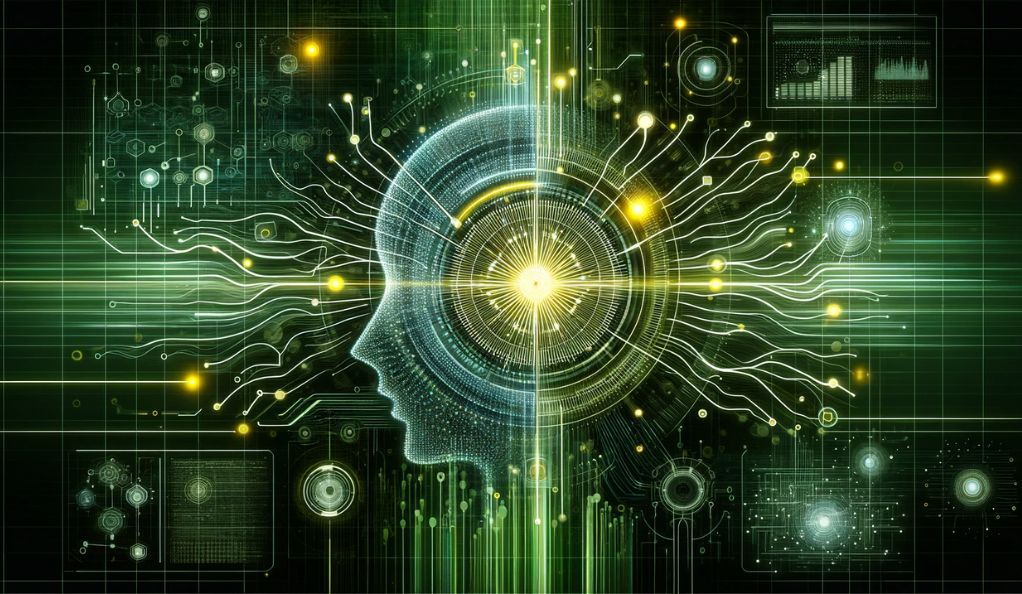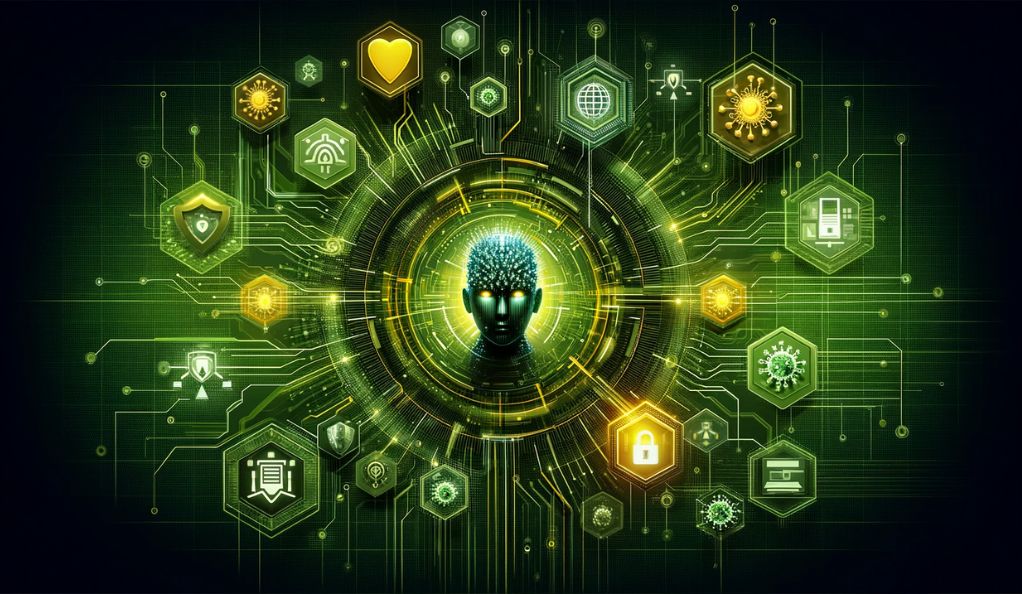Introduction to AI in Cybersecurity
The realm of cybersecurity is witnessing a significant transformation with the integration of Artificial Intelligence (AI). This integration marks a pivotal shift in how digital threats are identified and neutralized, offering a more dynamic and proactive approach to cyber defense.
AI’s Role in Modern Cybersecurity
AI algorithms are increasingly being employed to detect complex cyber threats efficiently. These algorithms analyze vast amounts of data, identify patterns, and predict potential security breaches before they occur. This proactive stance is crucial in an era where cyber threats evolve rapidly.

- Data Analysis: AI systems can process and analyze data at a scale impossible for humans, identifying hidden threats.
- Real-time Protection: AI provides continuous monitoring and instant response to security incidents, enhancing overall protection.
Enhancing Threat Detection with AI
The use of AI in cybersecurity extends beyond mere threat detection. It involves developing sophisticated systems capable of learning and adapting. This adaptive capability ensures that AI systems can keep up with the constantly changing tactics used by cybercriminals.
- Adaptive Learning: AI systems continuously learn from new data, improving their threat detection capabilities over time.
- Predictive Capabilities: AI can forecast future attack trends, allowing for preemptive security measures.
AI’s integration into cybersecurity represents a forward-thinking approach, empowering organizations to stay one step ahead of cyber threats. Its ability to rapidly analyze data, coupled with its adaptive learning capabilities, makes AI an indispensable tool in the ongoing battle against cybercrime.
AI-Powered Threat Detection and Response
The integration of Artificial Intelligence (AI) in cybersecurity has ushered in a new era of threat detection and response. AI’s advanced capabilities allow for the early identification of potential threats and quick action to mitigate them, enhancing the security framework of organizations.
Enhancing Detection with AI Technology
AI revolutionizes threat detection by employing sophisticated algorithms to analyze data patterns indicative of cyber threats. This technology excels in identifying subtle anomalies that traditional methods might miss.
- Advanced Pattern Recognition: AI algorithms analyze network traffic to detect unusual patterns, signaling potential threats.
- Continuous Monitoring: AI systems monitor networks 24/7, offering real-time detection of security breaches.
Accelerating Response to Cyber Threats
Once a threat is detected, AI systems can respond almost instantaneously. This swift action is vital to minimize the damage of cyberattacks.
- Automated Responses: Upon threat detection, AI can execute pre-programmed actions like isolating affected systems.
- Adaptive Learning: After an incident, AI systems learn and adapt, enhancing their future response strategies.
AI’s role in threat detection and response is pivotal in modern cybersecurity. Its ability to rapidly analyze and act on data makes it a critical tool for organizations in safeguarding their digital assets against ever-evolving cyber threats.
Predictive AI and Future Trends
Predictive AI is becoming a cornerstone in shaping the future of cybersecurity. This technology not only forecasts potential threats but also prepares organizations to counteract these risks proactively.

Forecasting Cybersecurity Threats
Predictive AI utilizes machine learning to analyze historical data and predict future cyber threats. This proactive approach allows organizations to prepare defenses against potential vulnerabilities.
- Data Analysis: By examining past cyber incidents, AI can identify patterns and predict future attacks.
- Proactive Measures: Organizations can implement security measures in advance, based on AI’s predictions.
Shaping Future Cyber Defense Strategies
As AI technology evolves, it will play a crucial role in developing advanced cybersecurity strategies. Future trends indicate a shift towards more AI-driven security solutions.
- Adaptive Security Systems: AI will lead to more dynamic and responsive cybersecurity measures.
- Continuous Improvement: AI systems will constantly learn and adapt, enhancing their predictive accuracy over time.
Implementing AI in Cybersecurity Frameworks
Incorporating Artificial Intelligence (AI) into cybersecurity frameworks is a strategic move for enhancing digital defense systems. This integration involves careful planning and execution to ensure that AI tools effectively complement existing security measures.
Planning for AI Integration
The first step in implementing AI in cybersecurity is planning. This involves understanding the specific security needs of the organization and identifying how AI can address these needs.
- Assessment of Current Security Posture: Evaluate existing security systems to identify areas where AI can enhance protection.
- Defining Objectives: Set clear goals for what the AI system needs to achieve in the cybersecurity framework.
Effective Deployment of AI Tools
Once the planning phase is complete, the next step is the deployment of AI tools. This phase requires technical expertise to integrate AI systems seamlessly into the existing cybersecurity infrastructure.
- Integration with Existing Systems: Ensure AI tools work in harmony with current security measures.
- Training and Testing: Train the AI system with relevant data and test it thoroughly to ensure effectiveness.
Emerging Threats and AI-Driven Defense Strategies
The cybersecurity landscape is constantly evolving, with new threats emerging regularly. AI-driven defense strategies are crucial in addressing these sophisticated cyber challenges.

Understanding the New Wave of Cyber Threats
As technology advances, cyber threats become more complex. These include advanced phishing attacks, ransomware, and sophisticated malware designed to bypass traditional security measures.
- Phishing Attacks: AI can identify and block phishing attempts more effectively than traditional methods.
- Ransomware: AI-driven systems can detect and isolate ransomware attacks rapidly, minimizing damage.
AI as a Defense Mechanism
AI is not just a tool for detecting threats; it’s an essential component of modern defense strategies. By leveraging AI, cybersecurity systems can adapt and respond to threats more dynamically.
- Adaptive Security: AI systems learn from each attack, continuously improving their defense tactics.
- Proactive Measures: AI can predict and mitigate potential threats before they materialize.
Preparing for Quantum Computing and Regulatory Compliance
The advent of quantum computing and evolving regulatory landscapes are reshaping cybersecurity strategies. Preparing for these changes is essential for maintaining robust digital defenses.
Addressing Quantum Computing Challenges
Quantum computing poses significant challenges to traditional encryption methods. Its ability to process complex calculations rapidly can potentially break current cryptographic codes.
- Developing Quantum-Resistant Encryption: It’s crucial to explore and implement encryption methods that can withstand quantum computing capabilities.
- Ongoing Research and Development: Staying abreast of advancements in quantum computing and adapting cybersecurity strategies accordingly.
Navigating Evolving Regulatory Compliance
As digital privacy concerns grow, regulatory bodies are implementing stricter data protection laws. Compliance with these regulations is critical for any cybersecurity framework.
- Understanding GDPR, CCPA, and Other Regulations: Familiarize with global data protection regulations and their implications on cybersecurity.
- Implementing Compliance Measures: Ensure cybersecurity strategies are aligned with legal requirements, reducing the risk of penalties.
Conclusion
The future of cybersecurity is intricately linked with the advancement of AI. From enhancing threat detection and response to predicting future risks, AI is a game-changer in the digital defense landscape. It addresses the challenges of quantum computing and ensures regulatory compliance, providing robust solutions to complex problems. However, the cybersecurity skills gap remains a critical issue. Addressing this through education, training, and AI integration is vital for a comprehensive cybersecurity strategy. As we navigate this ever-evolving domain, the synergy between AI capabilities and human expertise will be crucial in safeguarding our digital world against emerging cyber threats.








